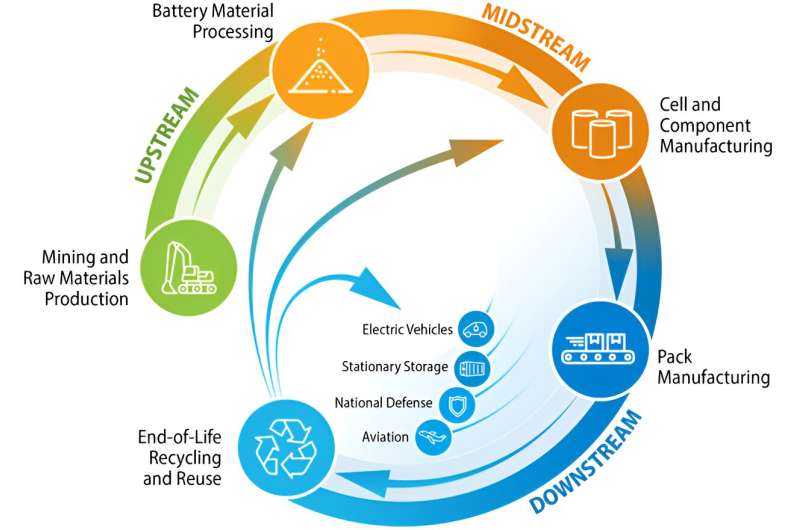This article has been reviewed according to Science X's editorial process and policies. Editors have highlighted the following attributes while ensuring the content's credibility:
fact-checked
trusted source
proofread
Battery supply chain database maps out the state of North America's manufacturing base

As the United States continues to transition to clean energy, strengthening the domestic supply chain by increasing the availability of critical materials is paramount to enabling greater domestic manufacturing.
This focus on securing the clean energy supply chain—in particular domestically—is a key part of the National Renewable Energy Laboratory's (NREL's) research supporting the energy transition. NREL researchers across clean energy technology areas investigate ways to optimize supply chains through data collection, assessments, benchmarking, and cost/sensitivity analyses.
NREL's support was critical to the recent U.S. Department of Energy (DOE) report, "America's Strategy to Secure the Supply Chain for a Robust Clean Energy Transition," which outlines key areas for strengthening supply chain resiliency, including increasing the availability of critical materials and expanding domestic manufacturing capabilities.
In addition, NREL is partnering directly with industry on lithium-ion batteries—one of the critical research areas identified in the report—to advance collaboration between U.S. private sector industries across the supply chain.
As part of ongoing efforts to map the battery landscape, NAATBatt International and NREL established the Lithium-Ion Battery Supply Chain Database to identify every company in North America involved in building lithium-ion batteries, from mining to manufacturing to recycling and everything in between.
NREL and NAATBatt have recently released a new version of this first-of-its-kind database—first launched in 2021—with additional entries and an online interface that makes it even easier to map and filter the hundreds of entries detailing companies and their facilities and various segments in the supply chain.
"In response to industry requests, we have made this release of the database more intuitive, with easy- to-find information about companies involved in any aspect of the supply chain," said NREL's Vicky Putsche. "We've even added an online version of the North American map to show a visual representation of where these companies are located."
"We added filters to find companies working in different parts of the supply chain, allowing industry to identify competitors and collaborators and to help policymakers understand the current state of the U.S. industry," said NREL's Maggie Mann, supply chain analytics group manager.
Scoping the early supply chain landscape
The lithium-ion battery manufacturing cycle interlinks facilities participating in specific phases of battery development like mining or processing raw materials. The U.S. Federal Consortium of Advanced Batteries' National Blueprint for Lithium Batteries developed a blueprint to establish and expand the domestic supply chain for lithium-ion batteries, shifting away from relying on global dependence for such batteries.
Both the Bipartisan Infrastructure Law and the Inflation Reduction Act passed by the U.S. Congress in 2021 and 2022, respectively, are investing billions of dollars in support of the battery and electric vehicles industries to develop a strong manufacturing supply chain in the United States.
The NREL-developed-and-managed Lithium-Ion Battery Supply Chain Database showcases key areas for coordination between supply chain companies, such as linking end-of-life facilities with midstream manufacturing capabilities.
"This database is an important step in better understanding the lithium-ion battery market and its North American players," said NREL's Ahmad Pesaran, the laboratory's chief energy storage engineer. "The new online interface makes it even easier for companies in the supply chain and individual companies to find and connect with other players in this space, ultimately strengthening our supply chain security."
As of March 2024, the database now offers a directory of nearly 700 companies and 850 facilities in North America across lithium-ion battery supply chain segments, including mining, material processing, cell and pack manufacturing, research and development, services, end-of-life management, and product distributors.
It also includes important information on each facility, including company, location, workforce, and type of products and services. Critically, the database summarizes key information such as installed battery manufacturing capacity and material production capability, plans for future capacity, types of chemistries and processes, and expansion plans by segment (e.g., upstream and downstream). An Excel version of the database is also available with detailed source information.
Additionally, the updated database includes other new and improved features:
- An easy-to-use interactive map to explore facilities, companies, and segments within the database directory, offering users the ability to search and filter products and companies by keyword, location, and supply chain segments and sub-segments
- Numerous new companies and facilities
- Changes to existing facilities, such as updates in volume production or workforce
- A new segment for professional services such as legal, investment, consulting, and insurance services that are expert in the battery space.
In the span of under three years, the number of companies/facilities in the North American lithium-ion battery supply chain has doubled—increasing from more than 400 to over 800 from September 2021 until March of 2024, Pesaran added. This increase has been the most notable for raw material manufacturing facilities, jumping from only about 25 to more than 80.
"We're proud that we've been able to strengthen the database's offerings to provide a more comprehensive picture of the supply chain landscape in lithium-ion battery material processing, manufacturing, and recycling," Pesaran said. "We have received a lot of compliments on the value and usefulness of the database."
Help us update the database
As the lithium-ion battery supply chain landscape grows, the online database will keep pace with that growth.
Click on "Access Database" on the website to access the new online interface and/or download the Excel version of the database.
The database is regularly updated. To add your company or update your information, fill out the database questionnaire. All companies in the database are encouraged to review these updates and email NREL with any corrections.


















